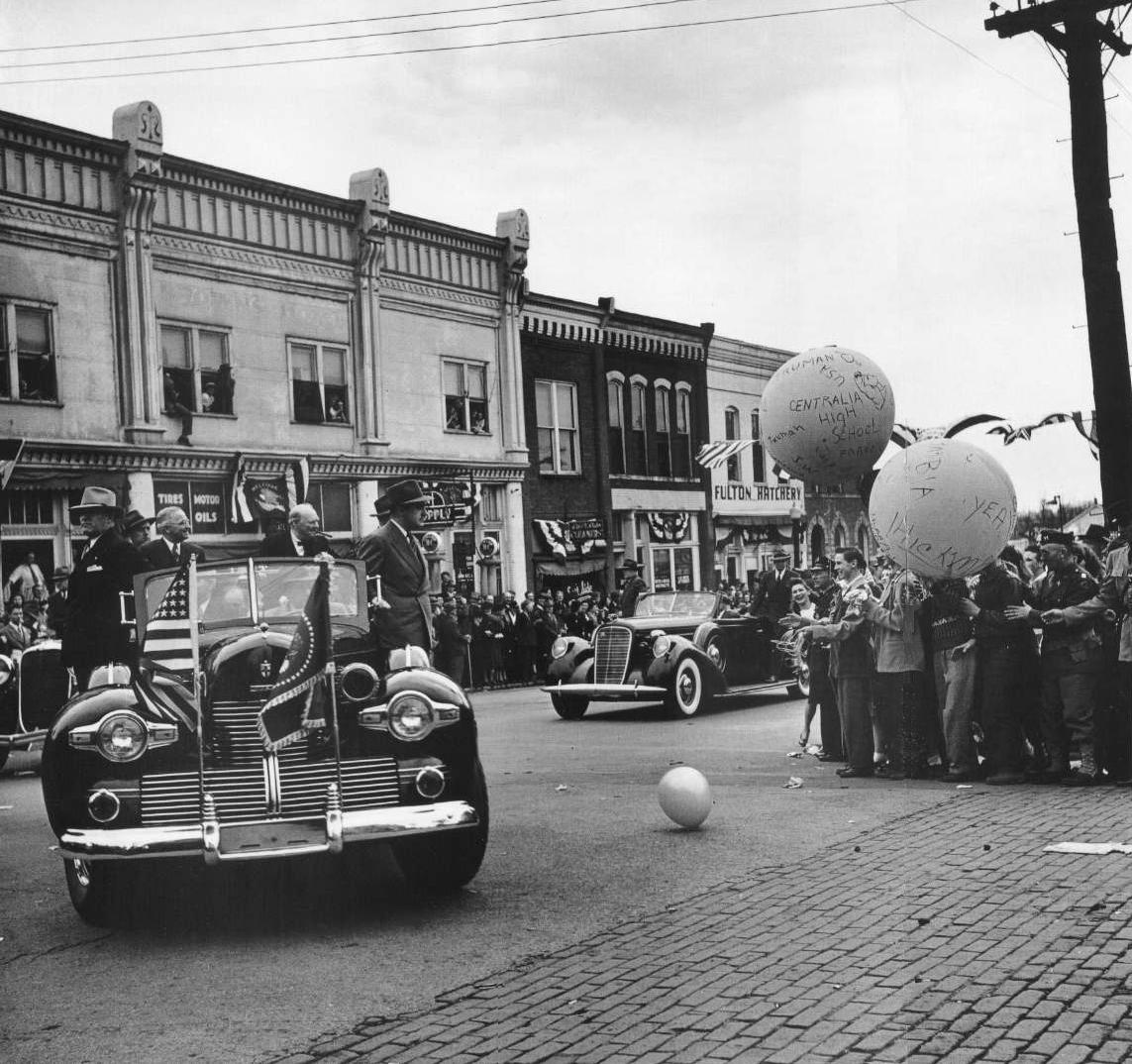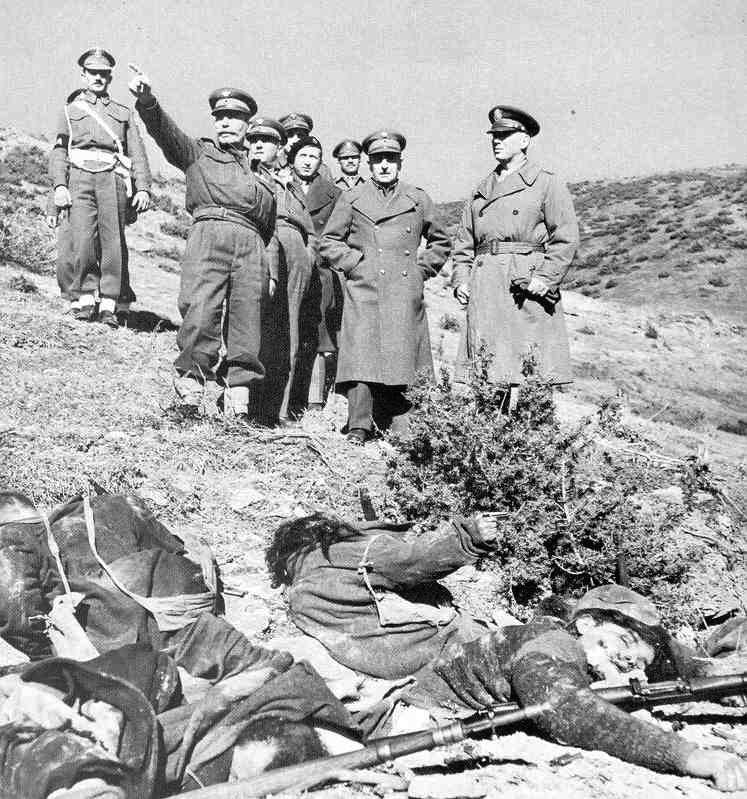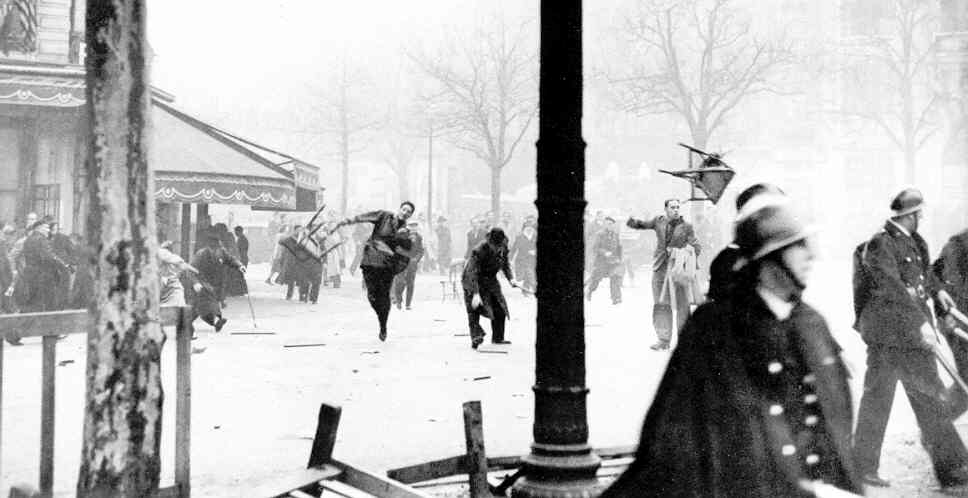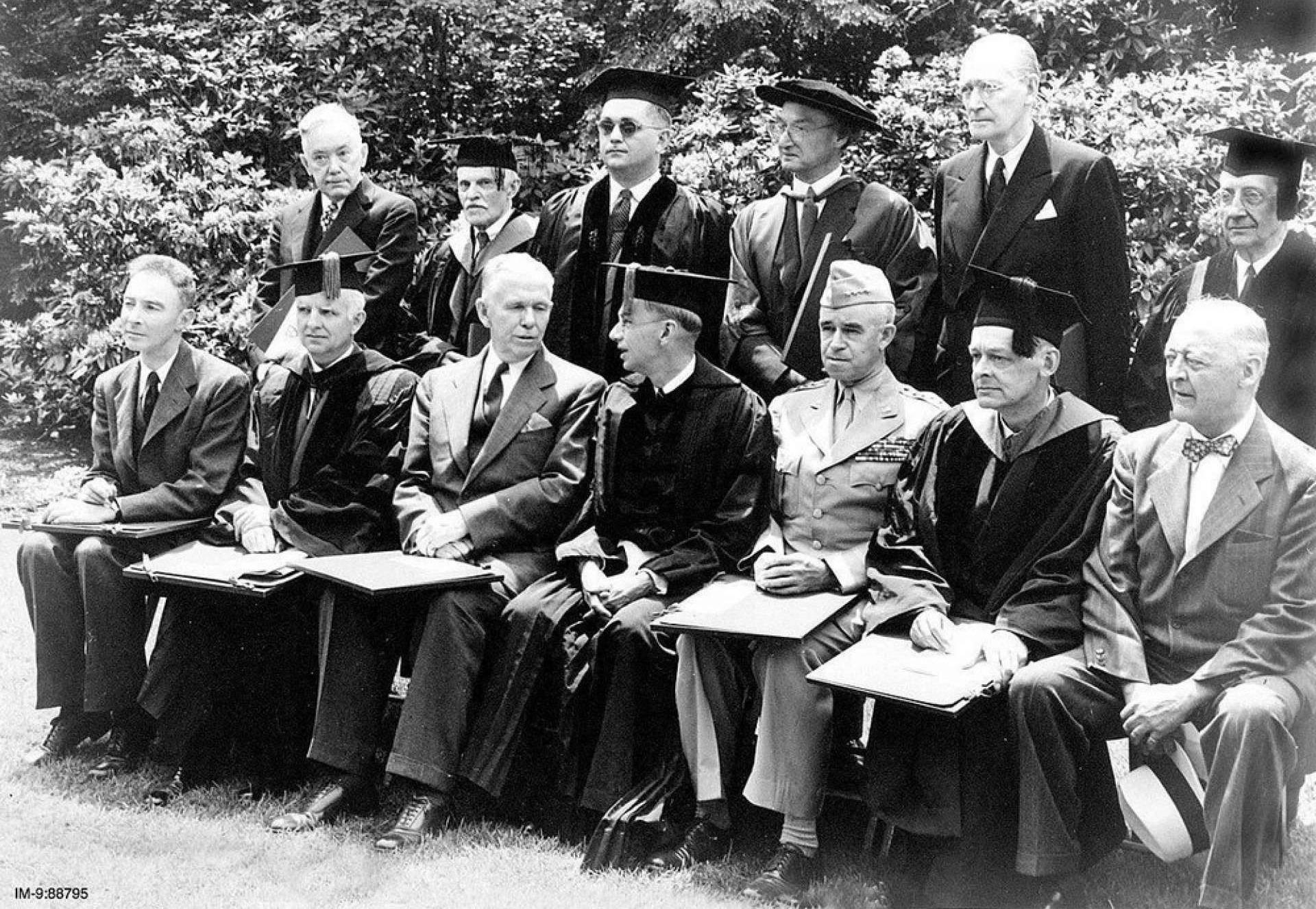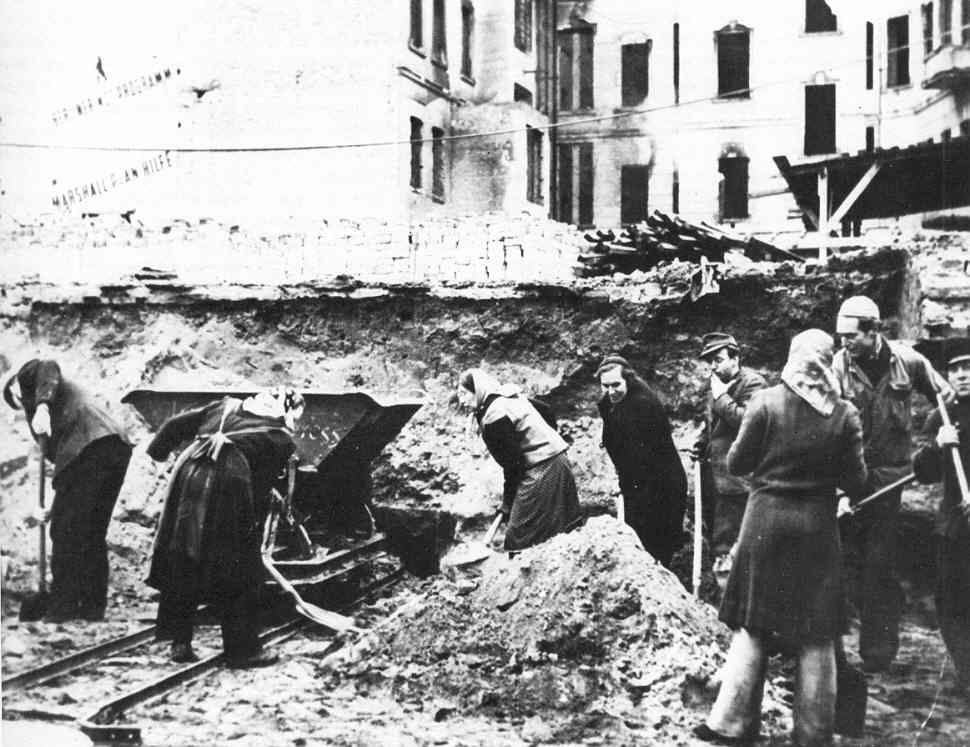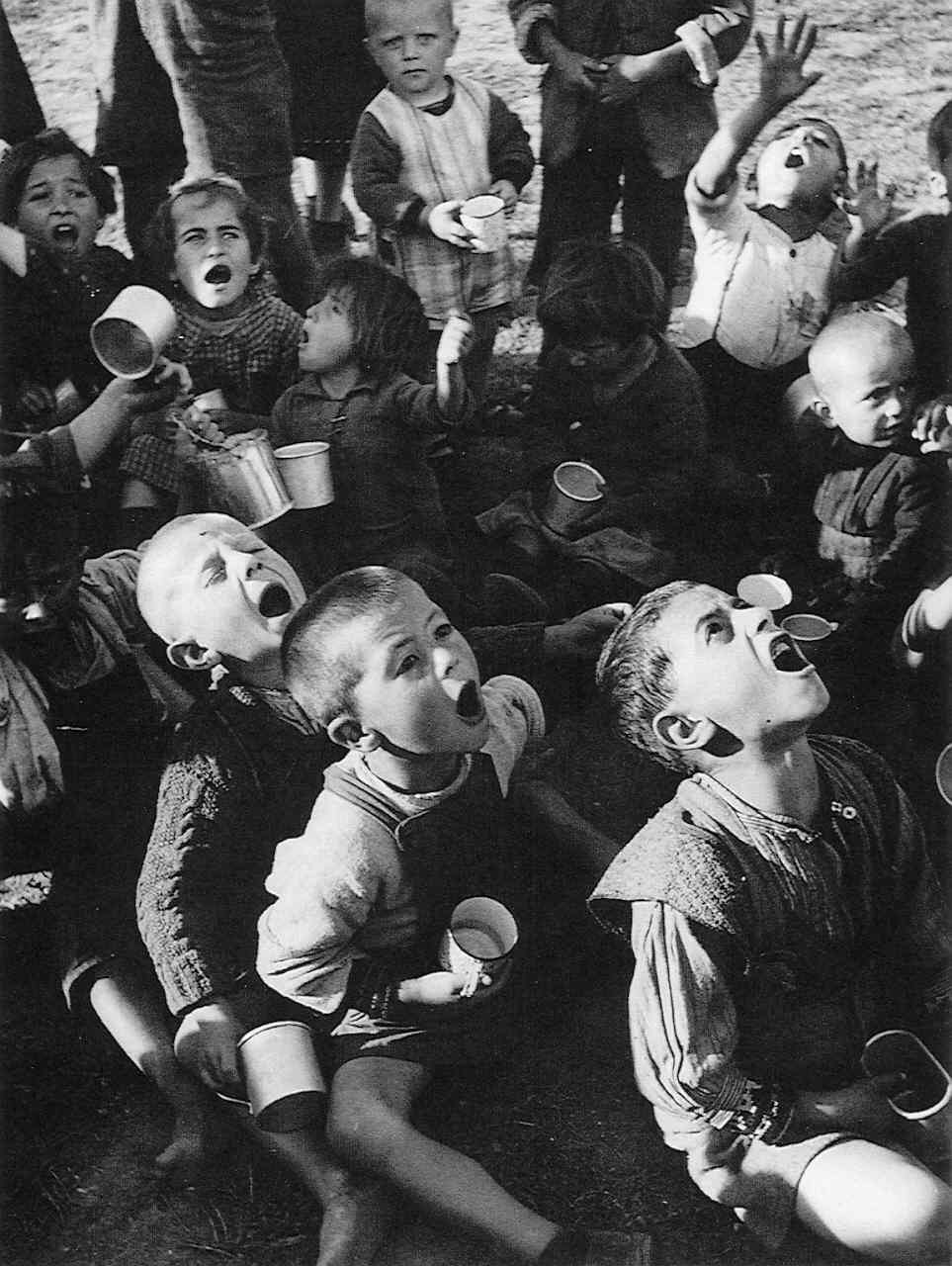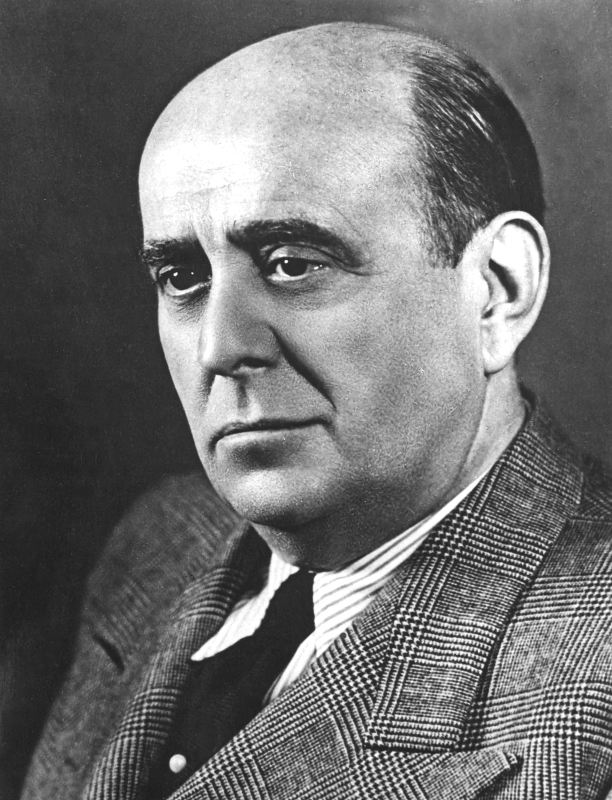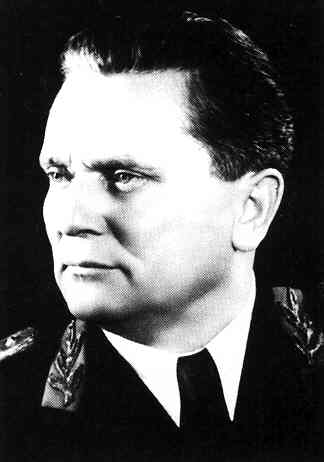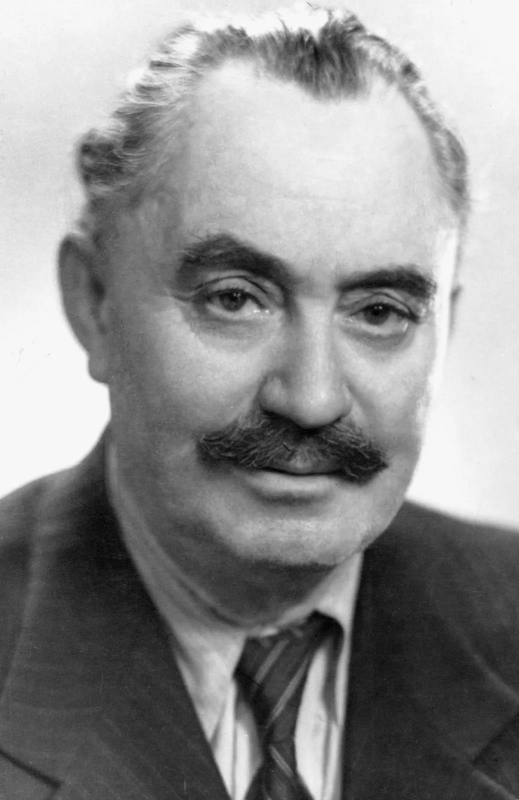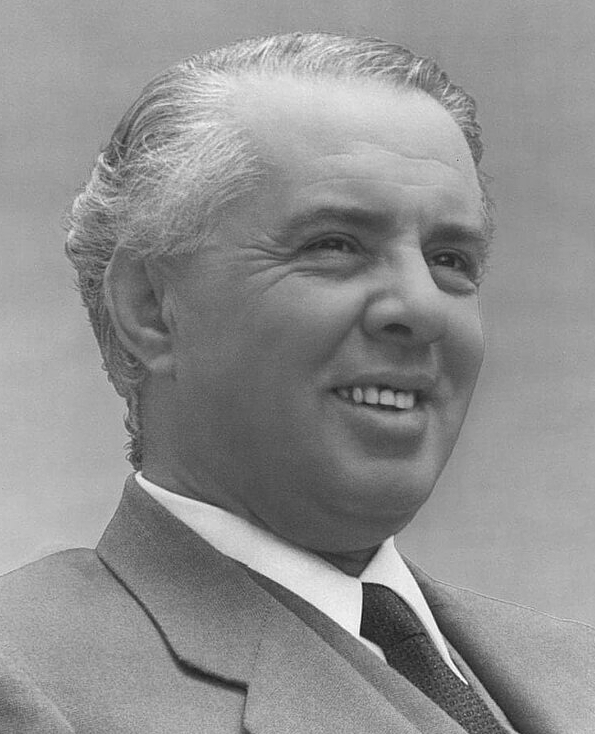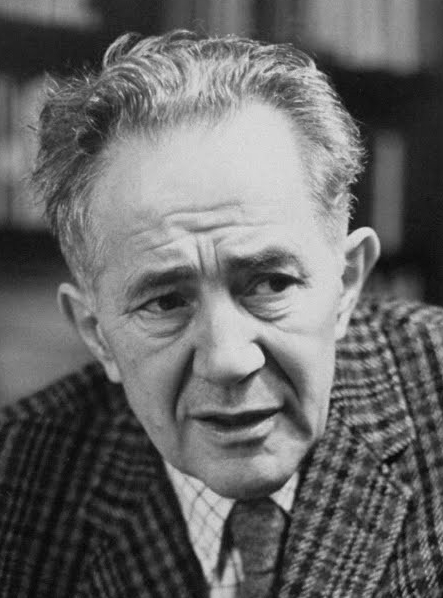18. A COLD WAR DEVELOPS


A "COLD WAR" SETS IN
 Iran
Iran
 Churchill's "Iron Curtain" warning
Churchill's "Iron Curtain" warning
(March 1946)
 Early steps in the "containment" of
Early steps in the "containment" of
Communism
 Crisis in Greece and Turkey ... and the
Crisis in Greece and Turkey ... and the
"Truman Doctrine"
 Serious economic problems and labor
Serious economic problems and labor
strife in post-war Europe
 The creation of the Marshall Plan
The creation of the Marshall Plan
 The Communist coup in Czechoslovakia
The Communist coup in Czechoslovakia
 However ... Tito's Communist Yugoslavia
However ... Tito's Communist Yugoslavia
goes its own way
The textual material on page below is drawn directly from my work
A Moral History of Western Society © 2024, Volume Two, pages 237-247.
IRAN |
CHURCHILL'S "IRON CURTAIN" WARNING (March 1946) |
| An
early warning about this growing East-West problem – and the
accompanying danger to world peace – occurred in March of 1946.
Churchill, then no longer in political office thanks to the British
voters, came to America and then accompanied Truman to Westminster
College in Truman's home state of Missouri. Churchill was due to
receive an honorary degree from the college … and deliver what would
become one of the world's greatest speeches. In his acceptance speech, he warned America of a growing danger coming from Stalin’s ambitions … an "Iron Curtain" that was descending on Europe – stretching across central Europe from the Baltic Sea in the North to the Adriatic Sea in the south … separating democratic Western Europe from a heavily Soviet-controlled Eastern Europe. In effect, he was appealing to America to take up Britain's old role of "balancer of power" on the European continent … for a tired Britain was no longer up to the challenge. Americans needed to understand Stalin's broken promises about free elections in Europe as a gauntlet thrown down in challenge at the feet of his former allies. And Americans needed to know that only America was fully equipped to take on that Soviet challenge. America had the power, the kind of power that Stalin respected – the only thing, in fact, that he respected. And if America did not quickly move to exercise that counter-balancing power, the West (including America) would soon enough find itself involved in yet a third – and far more vicious – world war. Britain would stand with America. But America would have to take the lead. But a very Idealistic American press at that time responded quite negatively to this speech. They were shocked that Churchill would talk so openly in such a hostile manner about our Russian or Soviet Communist friends. They still saw the post-war peace in the idealistic terms that Roosevelt himself had laid out for Americans to expect. The press even accused Churchill of "grandstanding" – using his Iron Curtain speech to promote himself so as to gain entrance back into the halls of British power … exactly the same accusation leveled against Churchill in the 1930s when he was trying to warn Britain of the growing dangers posed by Hitler and his Nazis. Truman, meanwhile, had to move very cautiously on the matter. He was in full agreement with Churchill in seeing the dangers Stalin's ambitions posed to the West. But he was still viewed as an "accidental president" … with little regard or support for him coming from a nervous American citizenry. But Truman was not playing the political game of doing whatever was necessary to win greater popular support. As president of the United States, he had a job to do … and intended to do his best as such. |
Things begin to stir with Churchill's "Iron Curtain Speech" delivered to Americans in 1946
President Truman and former
British PM Churchill arriving in Fulton, Missouri - March 5, 1946
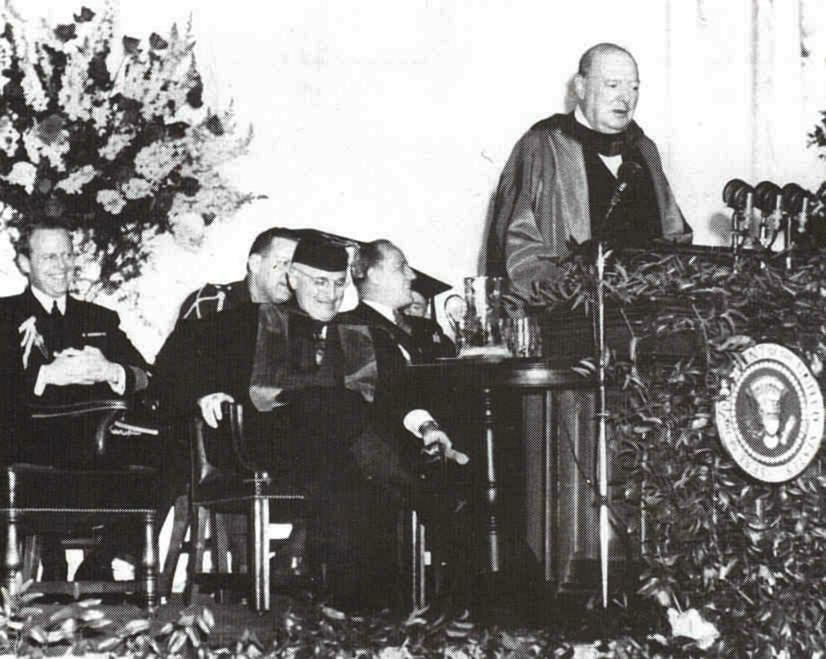
Winston Churchill delivering his "Iron Curtain" speech at Westminster College, Fulton, Mo. - March 5, 1946
EARLY STEPS IN THE "CONTAINMENT" OF COMMUNISM |
| Truman
himself had never any intention of starting up a shooting war with
Russia. But soon after his arrival in office in 1945, he had made
up his mind to block Stalin's plans to expand his influence much beyond
a theoretical line drawn around the Soviet Russian position as it found
itself at the war's end in mid-1945 – that is, a political line that
Churchill would describe in detail in his Iron Curtain speech. In
short, Truman was already planning to "contain" Soviet influence … as
he clearly demonstrated in his response to Stalin's Iranian involvement. Actually the term for just this policy of "containment" came from a State Department official posted in Kiev, George F. Kennan. He answered a request by the U.S. Treasury Department to explain why the Soviets were unwilling to cooperate with the new World Bank (IBRD) and the International Monetary Fund (IMF). Kennan's response was quite bold … given the State Department's presumption at that time that the dream of friendship with the Soviets would continue as it had during the war years. In Kennan's Long Telegram, he discussed the Soviet's anti-capitalist mindset – reinforced by Russian nationalist instincts – as the basis of the problem. He also described the dangers facing America and Europe if these very expansive Soviet-Russian instincts were not somehow "contained." This paper in turn inspired a larger Kennan study (September 1946) of Soviet goals and possible strategies. This was intended for the president's eyes only. But so clear in its analysis and strategic thinking – and useful as a tool to get this understanding out to the American public – that the decision was made to have it published anonymously. Thus – with its author identified only as "X" – it was presented to the larger American world in the prestigious journal, Foreign Affairs (July 1947). So it was that America was step by step led to understand that, although World War Two was over, America could not just "go home" … but needed to take the lead in helping Europe not fall under Stalin's tyrannical grip (much like what Hitler had just done to Europe and the world) … and – by responding quickly to this rising challenge coming from the Soviet East – also help the world not fall into yet a Third World War. |
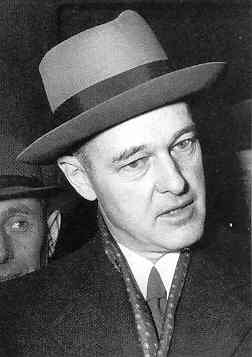
US diplomat George Kennan who in his "Long Telegram" of 1946 advocated "containment" of an expansive Soviet Communism
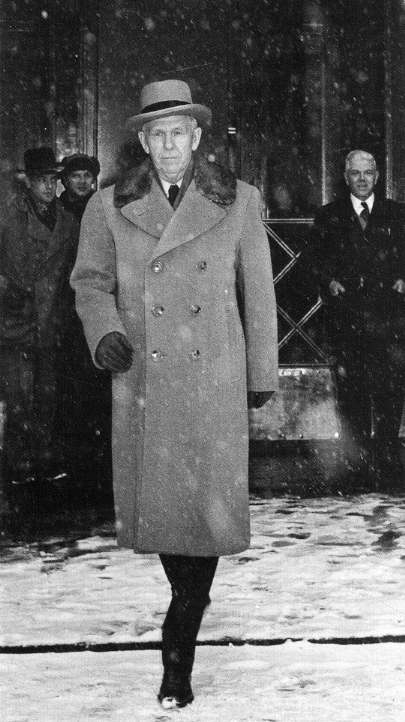
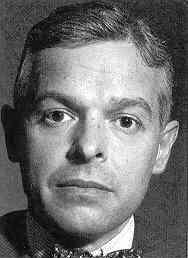
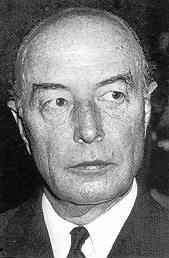
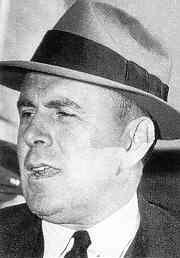
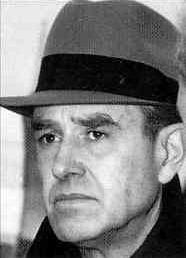
CRISIS IN GREECE AND TURKEY ... AND THE "TRUMAN DOCTRINE" |
| This
awakening was furthered greatly by developments taking place at the
eastern end of the Mediterranean. Communists were attempting to
take over Greece – which would clearly expand Stalin's Communist realm
… the supposition being that any advance of Communism was automatically
an advance of Stalinism, a supposition that not only Americans but also
Stalin himself held. Also … with Iran no longer a possibility for Russia to break out of its continental isolation, Turkey looked like a possibility for Stalin … if Turkey would yield to Soviet pressure and surrender its sovereign rights over the Dardanelles passage from the Black Sea to the Aegean Sea and thus the very strategic Mediterranean Sea as well. In both instances the situation was a bit trickier for Stalin … for there were no Soviet troops in occupation of either country. He would have to rely on local Communist organizations to do the work for him. Actually, in the case of Greece, he had the support of the Communist Yugoslav president Marshall Josip Broz Tito … who was sending his men and finances into neighboring Greece to help the Greek Communists in their effort to overthrow the newly elected (1946) Greek government. There were Communists also in Turkey … though their position there was weak. Traditionally, it was Britain that was expected to monitor such developments in the Eastern Mediterranean … as it had done in the mid-1800s in protecting the Turks from Russian expansion in the Crimean War. And the British were traditionally looked to for help in stabilizing Greek politics when it got unruly. But it was a different Britain now, with Atlee and his Labour Party having taken over the British government. Truman, however, was quick to take up this Communist challenge directly. On March 12, 1947, he appeared before Congress to request $400 million in American military and economic assistance to combat the takeover of those two countries by agents of coercion. He explained his program as America's determination to see that free peoples everywhere remained free … and that America would never allow any free country to fall under the power of totalitarian tyranny. "Communism" was not specifically mentioned as the problem – nor were the Soviets or Yugoslavs – though by this time most people clearly understood at whom or at what the program was aimed. Specifically, Truman announced that America would directly aid Greece in its putting down any insurrection aimed at overthrowing the legitimate government of that country ... and would support Turkey in maintaining its military strength - and thus its national sovereignty. It took two months for the formerly isolationist Republican Party majority in Congress to agree to fund his financial assistance program to Greece and Turkey. But it held back the offer of direct military assistance to either country … at least for a little while. But the Republican Party was quickly coming around to an internationalist position. And soon American troops were authorized … as advisors (not warriors) to the Greeks. And the financial-material assistance to the Turkish military improved the Turkish position greatly ... shutting down Stalin's program of intimidation. This move to take up the traditional role of Britain as balancer and stabilizer of power in the Mediterranean Truman had now made official American policy. He had established a major post-war principle directing American diplomatic and military programming, a principle that the world came to term "the Truman Doctrine."
America now sees itself involved in a "Cold War"
By 1947, it was beginning slowly to dawn on an increasing number of Americans how right Churchill had been about this growing problem with Stalin's Russia. It was increasingly clear that "Stalinists" now ruled in most of the Eastern European countries behind the "Iron Curtain." The press now began to describe quite readily how these "Iron Curtain" countries had become in effect Soviet "satellite" countries, drawing their political direction entirely from Moscow. |
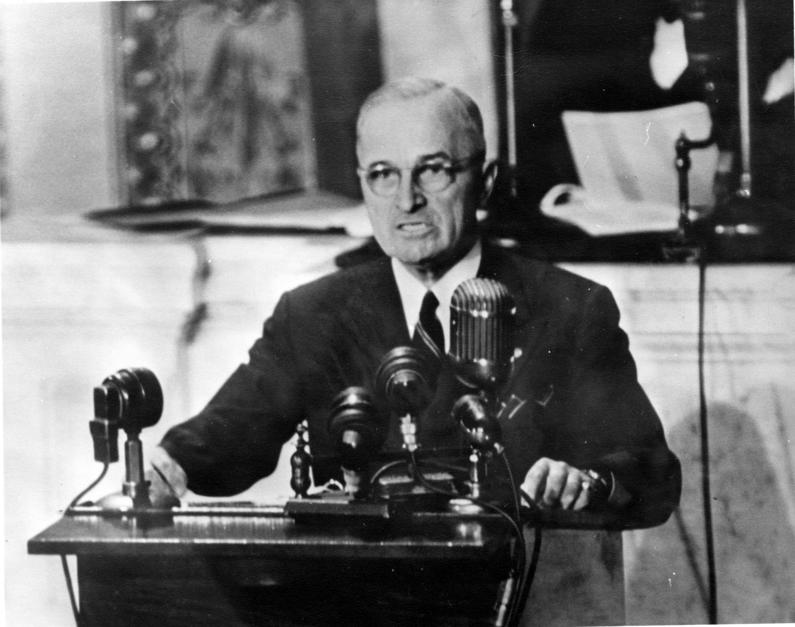
Harry S. Truman Library
and Museum

Greek women mourning the
loss of their men and boys murdered by Communist guerrillas who came through their Macedonian
town -- many killed because they had been seen talking to American military advisers
who had just come through the town - 1947
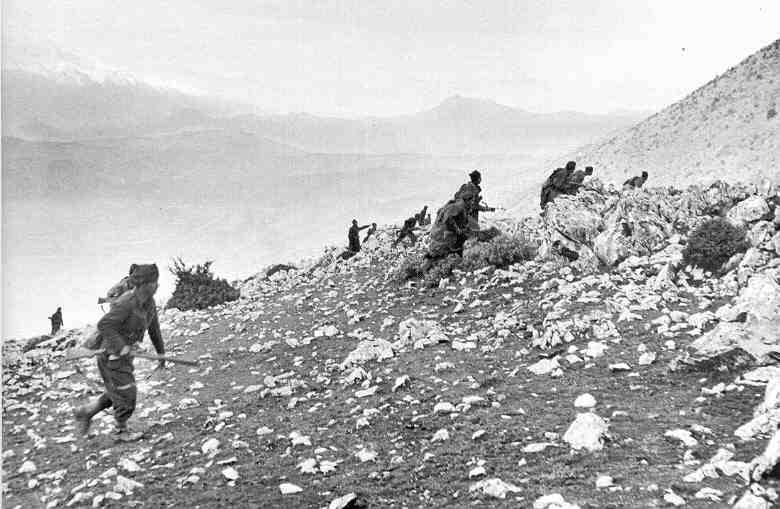
A Greek National Army patrol
sweeping toward the Albanian frontier
in search of Communist guerrillas - early 1948
Greek Commanders and Lt. General James A. Van Fleet, chief US military representative in Greece, standing over dead guerrillas near the Yugoslav border - May 1949
SERIOUS ECONOMIC PROBLEMS AND LABOR STRIFE IN POST-WAR EUROPE |
| At
first it looked as if the Western European countries coming out of the
war would be able to rebuild fairly quickly. With much war damage
to be repaired, there would be great need for full employment of the
soldiers returning to civilian life. And financing this
reconstruction were the war credits still enjoyed by the governments of
these countries. But by the winter of 1946-1947, most of this funding was drying up … with that funding ending up in American hands through the massive purchase of much-needed industrial items from the American factories still in full operation. A huge shortage of dollars needed to continue to purchase those infrastructure items had thus developed. Consequently, the economic rebound collapsed and employers had to reduce workers' wages … and even let go thousands of their workers. Trouble – big trouble – now developed. In April of 1947 many of the 30,000 French workers at the nationalized Renault plant went on strike … in response to the reduction in the bread rationing decreed by the Paul Ramadier cabinet … and just in general because of the deep Communist involvement in the French workers' world – always ready to blame capitalism as the cause of worker misery. Reacting to the ideological component in this event, Ramadier dismissed the Communists from his cabinet (early May). Then, although the government was quick to answer some of the workers' wage demands and bring the Renault strike to a close (mid-May), the idea of a general workers' strike itself spread widely across France. Again … the motif was both financial and ideological – with a formerly hesitant French Communist Party now fully behind these strikes ... with Stalin also doing what he could to direct this dynamic. Meanwhile in Italy, Italian premier Alcide De Gasperi, had visited America at the beginning of 1947 … to plead for gentler terms in the treaty formally ending the Allies' war with Italy – and to petition the Americans for serious financial assistance. The $150 million he was authorized increased immensely De Gasperi's standing before the Italian electorate. But it also clearly put him in America's growing anti-Communist camp … made even clearer when Truman responded to the spreading workers' strikes in Europe (and in Italy no less) in May by pressing De Gasperi to remove the Communists from his government ... joining the Vatican – which was demanding the same move against the Communists. |
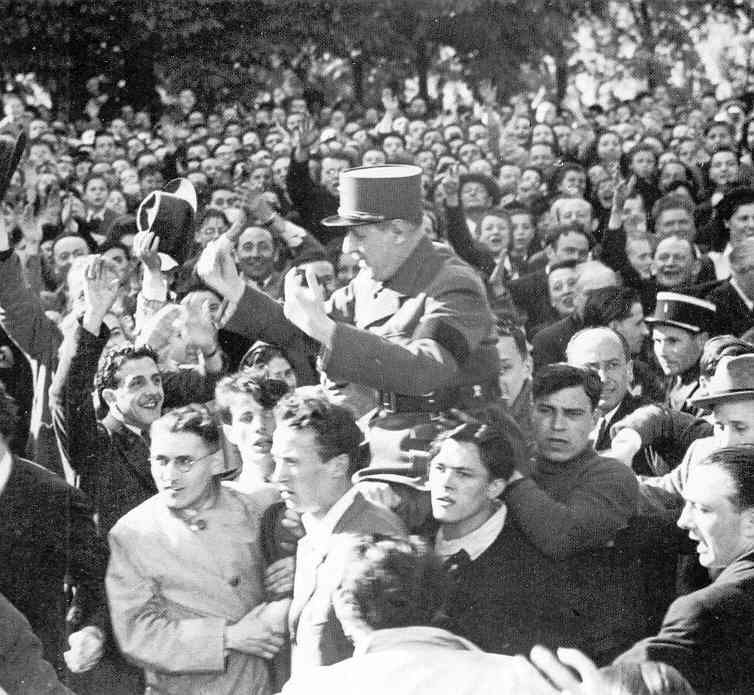
Charles de Gaulle leading
a rally outside Paris on May 1, 1948 (while Communists were holding
their May Day parade in downtown Paris)
Parisian Leftists attacking
police in protest against official Armistice Day celebrations -- November
11, 1948
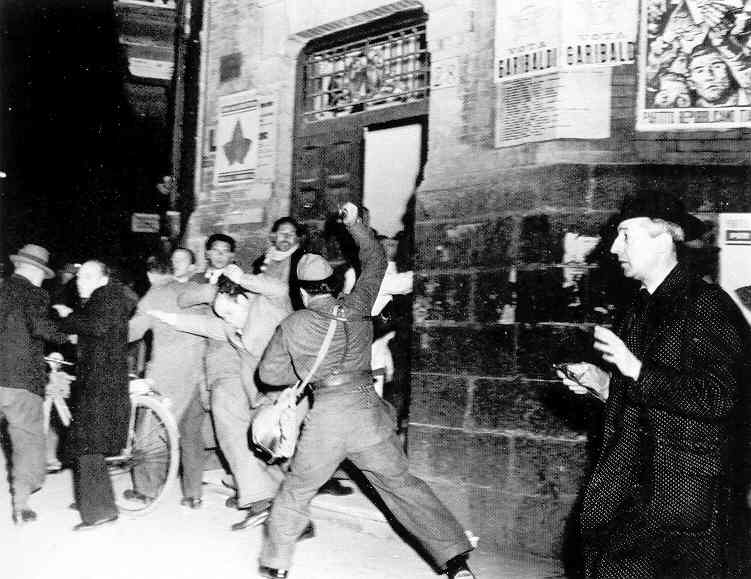
Italian police dispersing some of 50,000 Communists who had gathered to disrupt a rally of the Rightist Italian Social Movement – Rome - 1948
THE CREATION OF THE MARSHALL PLAN |
| At
this point, Europe's central banks had financed all that they could in
the effort to rebuild their war-torn economies. In fact many of
them stood at the threshold of bankruptcy. Truman, sensing the
danger that this posed to what was increasingly coming to be termed
"The Free World," knew that it was time to swing substantial American
financial support (the American economy in fact was booming at the
time) behind these staggering Western governments. Indeed, the
European worker's strikes which broke out in May of 1947 – and their
obvious Communist (and Stalinist) support and direction behind them –
made such countering American financial support an immediate
necessity.
Marshall's Harvard speech
Thus in early June of 1947, U.S. Secretary of State George Marshall, at a commencement address at Harvard University, informed the nation (and the world) of the need for America to bring such support to war-torn Europe … or disaster would result.
Marshall did not mention specifically the spread of Communism under these dire conditions … but few people missed the underlying assumptions about just such a challenge to the Free World. Indeed, the "Marshall Plan" as it was soon entitled,1 initially appeared to be no less open to the Soviet World than to the countries of Western Europe. And at first it appeared that countries of the Soviet bloc might be actually participating in the Marshall Plan. Nonetheless, in July of that year, 16 Western European countries gathered in Paris to discuss the Plan … and set up the means of international cooperation among their nations required under the Plan. Thus billions of U.S. dollars would be granted to Plan participants, not only to rebuild their respective nations but to provide the impetus for strong economic cooperation … overseen by the new Organization of European Economic Co-Operation (OEEC). Thus it was that a new European unity movement was birthed.
The Soviets answer with the Cominform and the Molotov Plan
Stalin was quick to respond to this American challenge by setting up his own organization, the Communist Information Bureau or "Cominform," established at a meeting he held in September of 1947 in Poland with leaders of the Communist Parties of both the Soviet "Bloc" (Poland, Hungary, Romania, Bulgaria, Czechoslovakia, and Yugoslavia) and the Western countries, France and Italy.2 Although the purpose of the Cominform was ostensibly only ideological – to help coordinate Communist doctrine and programming across the Communist world – it also had to be economic, to the extent of offering some response to the Marshall Plan … which was why the meeting was held in the first place. What specifically evolved along these lines was what would come to be termed the "Molotov Plan." Basically it was a system of trade agreements between Soviet Russia and the Soviet satellite states … designed to direct economic development in a way that strengthened the ties of the Eastern Bloc nations to the Soviet Union. As far as actually achieving strong economic development (which certainly the Marshall Plan did) the problem remained that economic assistance was easily offset by reparations payments those same nations were required to make to Soviet Russia … because a number of them had been former allies (willing or not) of Hitler.
America reorganizes its foreign policy instruments
with its National Security Act (1947) Recognizing America's heightened responsibilities in global affairs, Truman put together (1946) and Congress approved (July 1947) a proposal to unite the various military branches (army, navy, and army air force) into a single National Military Establishment,3 headed by a new Secretary of Defense (James Forrestal, 1947-1949). The Act also established a Central Intelligence Agency (CIA), upgrading the Central Intelligence Group set up the previous year … the new CIA under a Director of Central Intelligence (Roscoe Hillenkoetter, 1947-1950). It also established a National Security Council (NSC), uniting the heads of the various foreign policy agencies (State, CIA, Defense, etc.) in mutual service as foreign policy advisors to the president. 1Truman himself called for the Plan to go under Marshall’s name, knowing that Marshall had a much better standing than he did with the frugal Republicans of Congress, who would have to approve the huge spending that the Plan called for. 2The Cominform was actually replacing the older Soviet-run Communist International (Comintern) that had been disbanded during the war in 1943 ... in order to improve Soviet relations with its wartime allies in the West. 3Supposedly, the National Military Establishment (NME) was renamed in 1949 as the Department of Defense (DOD) … because the initials NME sounded like the word "enemy"! US Secretary of State (former
General) George C. Marshall at Harvard ...
about to deliver his "Marshall Plan" speech
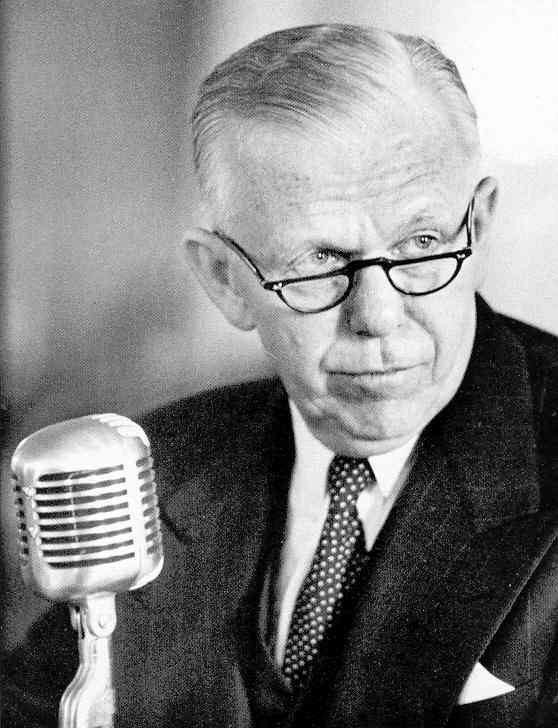
Marshall explains to Congress details of the European Recovery Program
(popularlay
named the "Marshall Plan" after him) in January 1948 Paid by funds from the US
Marshall Aid Plan, Berliners are employed to clear rubble and begin
reconstruction 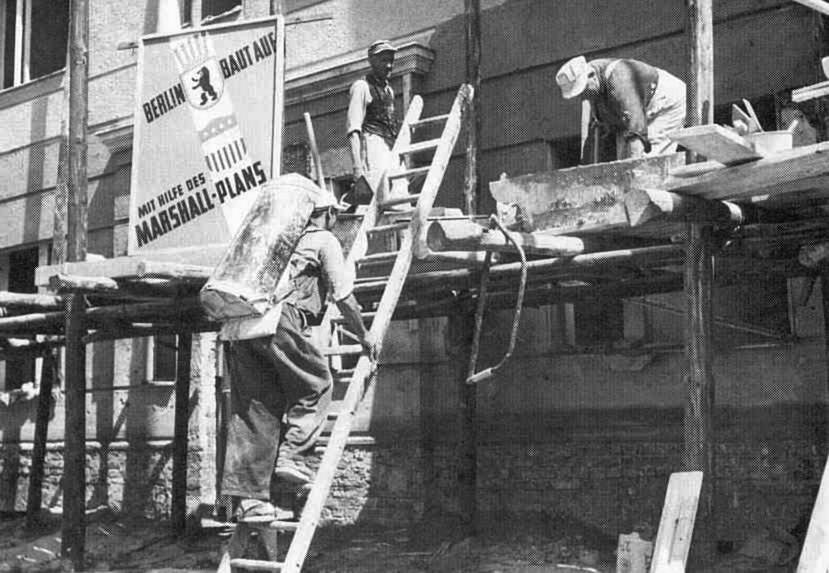
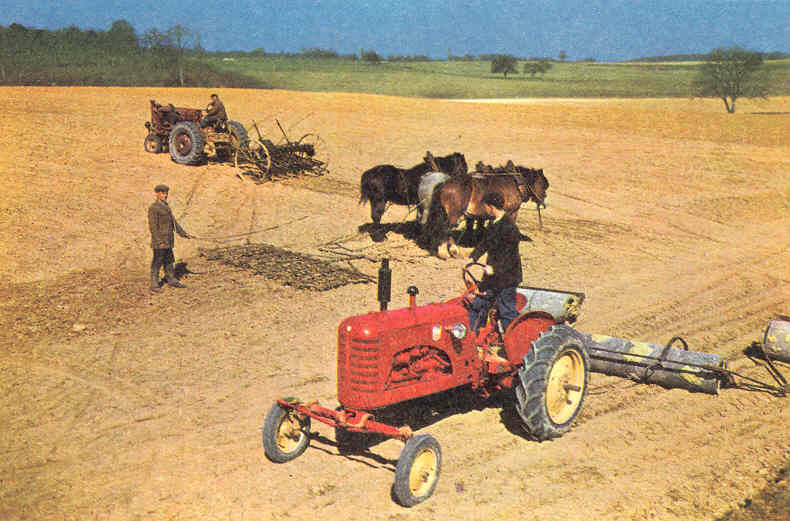
French farmer using a US
tractor sent under the Marshall Plan Hungry Greek children waiting
for their rations of powdered milk - 1948 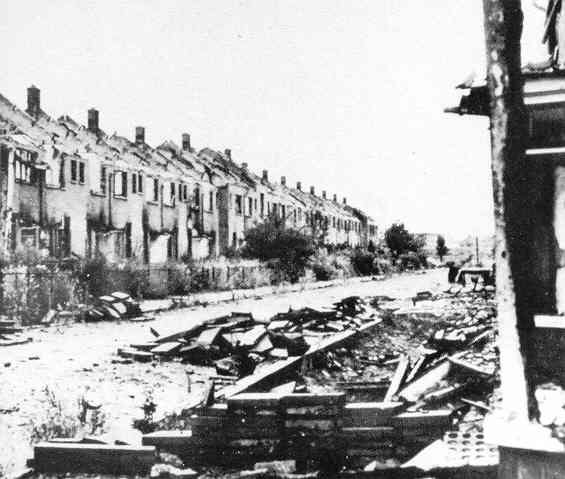
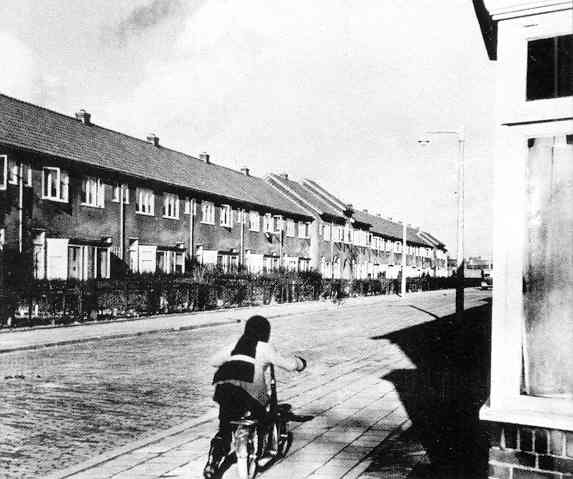
U.S. International Communications Agency 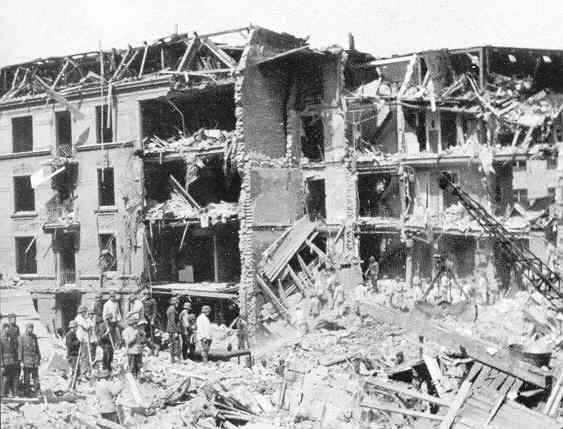
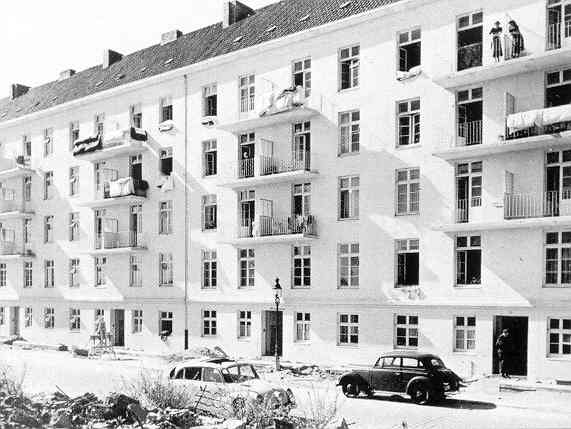
Hamburg apartment buildings
in 1943 and again in 1951
-- with the help of Marshall Plan assistance
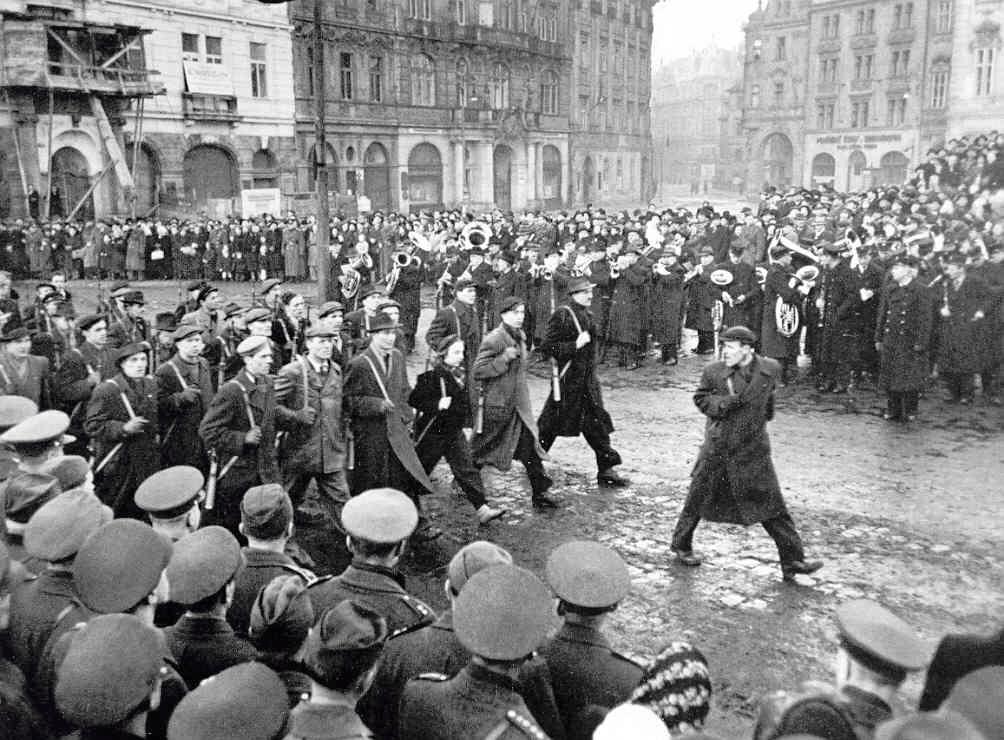
Armed Czech Workers' Militia who bullied non-Communists into submission marching through Prague in celebration of the new Communist government ruling Czechoslovakia Czech Foreign Minister Jan Masaryk (1940-1948). His death caused by falling from a window in March of 1948 was long debated as either
suicide or political murder ... and still unresolved to this day 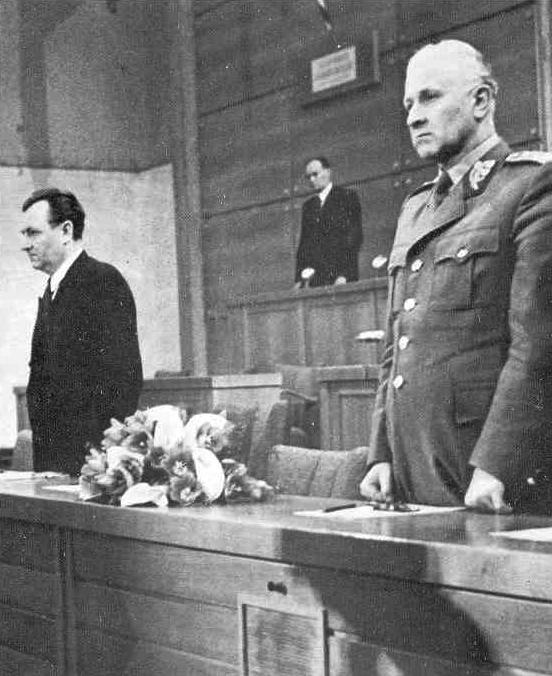
Pro-Western Foreign Minister Jan Masaryk honored by floral wreath and minute of silence by Communists Premier Klement Gottwald (left) and Defense Minister Ludvik Svoboda
|
